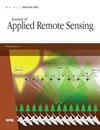Plume motion characterization in unmanned aerial vehicle aerial video and imagery
IF 1.4
4区 地球科学
Q4 ENVIRONMENTAL SCIENCES
引用次数: 0
Abstract
Sediment plumes are generated from both natural and human activities in benthic environments, increasing the turbidity of the water and reducing the amount of sunlight reaching the benthic vegetation. Seagrasses, which are photosynthetic bioindicators of their environment, are threatened by chronic reductions in sunlight, impacting entire aquatic food chains. Our research uses unmanned aerial vehicle (UAV) aerial video and imagery to investigate the characteristics of sediment plumes generated by a model of anthropogenic disturbance. The extent, speed, and motion of the plumes were assessed as these parameters may pertain to the potential impacts of plume turbidity on seagrass communities. In a case study using UAV video, the turbidity plume was observed to spread more than 200 ft over 20 min of the UAV campaign. The directional speed of the plume was estimated to be between 10.4 and 10.6 ft/min. This was corroborated by observation of the greatest plume turbidity and sediment load near the location of the disturbance and diminishing with distance. Further temporal studies are necessary to determine any long-term impacts of human activity-generated sediment plumes on seagrass beds.无人飞行器航拍视频和图像中的羽流运动特征描述
底栖环境中的自然和人类活动都会产生沉积物羽流,增加水的浑浊度,减少到达底栖植被的阳光量。海草是其环境的光合生物指示器,受到长期日照减少的威胁,影响到整个水生食物链。我们的研究利用无人飞行器(UAV)的空中视频和图像来研究人为干扰模型产生的沉积物羽流的特征。我们评估了羽流的范围、速度和运动,因为这些参数可能与羽流浑浊度对海草群落的潜在影响有关。在利用无人机视频进行的案例研究中,在无人机飞行的 20 分钟内观察到浊流扩散超过 200 英尺。据估计,羽流的定向速度在 10.4 至 10.6 英尺/分钟之间。在扰动位置附近观察到的最大羽流浊度和沉积物负荷也证实了这一点,并随着距离的增加而减小。有必要开展进一步的时间研究,以确定人类活动产生的沉积物羽流对海草床的长期影响。
本文章由计算机程序翻译,如有差异,请以英文原文为准。
求助全文
约1分钟内获得全文
求助全文
来源期刊

Journal of Applied Remote Sensing
环境科学-成像科学与照相技术
CiteScore
3.40
自引率
11.80%
发文量
194
审稿时长
3 months
期刊介绍:
The Journal of Applied Remote Sensing is a peer-reviewed journal that optimizes the communication of concepts, information, and progress among the remote sensing community.
 求助内容:
求助内容: 应助结果提醒方式:
应助结果提醒方式:


